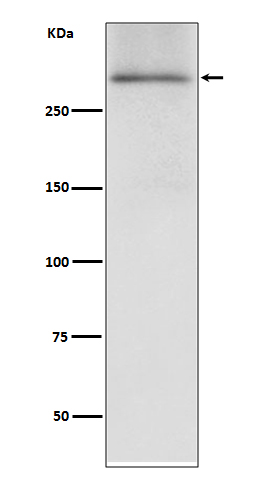
| WB | 咨询技术 | Human,Mouse,Rat |
| IF | 咨询技术 | Human,Mouse,Rat |
| IHC | 咨询技术 | Human,Mouse,Rat |
| ICC | 技术咨询 | Human,Mouse,Rat |
| FCM | 咨询技术 | Human,Mouse,Rat |
| Elisa | 咨询技术 | Human,Mouse,Rat |
| Aliases | BMD; CMD3B; DMD; Dystrophin;;Dystrophin |
| WB Predicted band size | 427 kDa |
| Host/Isotype | Rabbit IgG |
| Antibody Type | Primary antibody |
| Storage | Store at 4°C short term. Aliquot and store at -20°C long term. Avoid freeze/thaw cycles. |
| Species Reactivity | Human,Mouse,Rat |
| Immunogen | A synthesized peptide derived from human Dystrophin |
| Formulation | Purified antibody in PBS with 0.05% sodium azide,0.05% BSA and 50% glycerol. |
+ +
以下是3-4篇关于Dystrophin抗体的参考文献及其摘要概括:
---
1. **文献名称**: "Characterization of dystrophin in muscle-biopsy specimens from patients with Duchenne's or Becker's muscular dystrophy"
**作者**: Hoffman EP, et al.
**摘要**: 该研究首次开发并验证了针对dystrophin蛋白的特异性抗体,用于区分Duchenne和Becker型肌营养不良症患者的肌肉活检样本。通过免疫印迹和免疫组化分析,发现Duchenne患者几乎无dystrophin表达,而Becker患者存在截短型蛋白,为临床诊断提供了关键工具。
---
2. **文献名称**: "Dystrophin immunity in Duchenne's muscular dystrophy"
**作者**: Duan D, et al.
**摘要**: 研究利用多种dystrophin抗体(如抗C端和N端抗体),通过免疫荧光和Western blot评估基因治疗后dystrophin蛋白的恢复情况。结果显示,抗体检测的敏感性和特异性对治疗效果的定量分析至关重要。
---
3. **文献名称**: "Dystrophin-associated proteins in muscular dystrophy"
**作者**: Matsumura K, et al.
**摘要**: 通过比较不同dystrophin抗体的表位特异性(如抗杆状结构域和C端抗体),揭示了dystrophin与相关蛋白复合物(如sarcoglycan)的相互作用。研究强调了抗体选择对准确评估蛋白表达和定位的重要性。
---
4. **文献名称**: "Antibody-mediated exon skipping therapy for Duchenne muscular dystrophy"
**作者**: Cozzoli A, et al.
**摘要**: 研究采用抗dystrophin抗体(如抗rod domain抗体)监测外显子跳跃治疗后截短蛋白的表达。通过免疫组化和Western blot验证了抗体的可靠性,证明其在评估治疗效果中的实用性。
---
这些文献涵盖了dystrophin抗体的开发、验证及在基础研究与临床诊断中的应用,可作为相关实验设计的参考。
Dystrophin antibodies are essential tools in studying the structure, function, and pathology of dystrophin, a critical cytoskeletal protein that stabilizes muscle cell membranes during contraction. Dystrophin is encoded by the *DMD* gene, and mutations in this gene lead to Duchenne muscular dystrophy (DMD) or Becker muscular dystrophy (BMD), characterized by progressive muscle degeneration and weakness. The protein anchors the actin cytoskeleton to the extracellular matrix via the dystrophin-associated glycoprotein complex (DGC), ensuring mechanical stability and signaling in muscle fibers.
Antibodies targeting dystrophin are widely used in research and diagnostics to assess protein expression, localization, and integrity. In DMD/BMD, dystrophin is typically absent (DMD) or truncated (BMD), and immunohistochemistry (IHC) or immunofluorescence (IF) with specific antibodies helps confirm diagnosis. Western blotting quantifies dystrophin levels, differentiating severe DMD from milder BMD cases. These antibodies also aid in evaluating experimental therapies, such as exon-skipping drugs or gene editing, by detecting restored or modified dystrophin in preclinical models (e.g., mdx mice) or patient samples.
Multiple dystrophin isoforms exist due to alternative splicing, and antibodies targeting different epitopes (e.g., N-terminal, rod domain, C-terminal) help distinguish isoforms or detect specific mutations. Commercially available monoclonal and polyclonal antibodies vary in specificity, requiring validation for each application. Beyond diagnostics, they contribute to understanding dystrophin's role in muscle repair, membrane stability, and interactions with other DGC components, offering insights into broader neuromuscular pathophysiology.
×